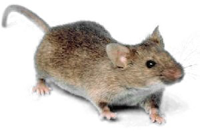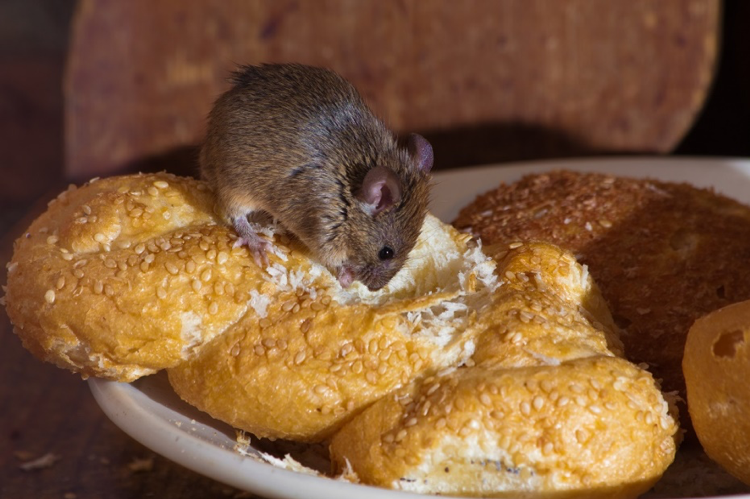 A mouse is a small nocturnal rodent that is very well suited to living in houses and other human made structures. Mice are often not seen by homeowners because they only come out at night, and they are usually identified through the damage they cause and the noises they make while out of sight. Their natural diet consists of seeds and grains, but they will eat many different things. Mice tend to nibble on things, making frequent trips to food sources within 25 feet of their nests. After mice enter your home, they can be extremely difficult to get rid of since they often live in hidden areas within garages, attics, lofts, and wall interiors.
A mouse is a small nocturnal rodent that is very well suited to living in houses and other human made structures. Mice are often not seen by homeowners because they only come out at night, and they are usually identified through the damage they cause and the noises they make while out of sight. Their natural diet consists of seeds and grains, but they will eat many different things. Mice tend to nibble on things, making frequent trips to food sources within 25 feet of their nests. After mice enter your home, they can be extremely difficult to get rid of since they often live in hidden areas within garages, attics, lofts, and wall interiors.
How can I tell if I have mice?
Mice only need a ¼ inch gap to enter your home, so homeowners need to seal up any obvious gaps around entry doors, garage doors and utility penetration points that are a ¼ of an inch or larger. Mouse activity can be present year round.
Droppings – Mice constantly eat throughout the day, which is a lot for their little bodies. Droppings are left behind and will appear to be black or brown in color and the shape of a grain of rice.
Scratching – They are nocturnal creatures. If you hear light scratching in your home at night, it could be mice.
Tampered food – While in search of shelter, mice are also in search of a food source. It’s much easier to eat food from your pantry than search for food outside in the elements. Signs of tampered food are cereal boxes or other pantry items that look like they were chewed through along the edges.
Mice – You may actually see mice. They crawl along edges of walls so you probably won’t see them running through the middle of a room.
Why do I have mice in my home?
What many homeowners don’t realize is that mice can squeeze through holes much smaller than their body size, making it possible for them to into your home through even the smallest of holes on the exterior of your home. Mice can actually fit into holes as small as a dime and can quickly slip into your home unnoticed. If you take a walk around the exterior of your home and notice any openings, no matter how small, that could be a point-of-entry. Mice can enter within small openings near electrical, gas, water or even air conditioning connections that lead into your home. There may also be gaps that aren’t visibly accessible which are covered by siding or moldings that can allow rodents to get in. Rodents can find entry points that you might not even be aware of.

A mouse’s food source isn’t limited to what we perceive as a food source. A food source for rodents can include bird seeds or even grass seeds, so if you have those readily available in your garage, you should use it up or store it in a heavy-duty container to keep the mice out.
Nests can be found pretty much anywhere within a home or on the property. The most common hiding places for mice nests are:
- Wall Voids
- Insulation
- Attics
- Under Refrigerators
- Under Stoves
- Under Dishwashers
Secure and protected areas with little activity that provide close access to food and water are ideal locations for mouse nesting.
Why should I be concerned with mice?
Having rodents inside your home can cause major serious sanitation issues. Because they are so small, mice need to eat very frequently throughout the day. Unfortunately, this leads to very large amounts of droppings (usually the first sign of mouse activity) and urine wherever they travel. Salmonella bacteria from rodent feces makes food poisoning a real concern when they get into your kitchen. Simply preparing a meal in the kitchen will be risky. Mice are excellent climbers. Once they claim your home as their own, mice and climb through holes between floors of your home and show up in your basement and living room all in the same day. Their oily bodies leave what are called “rub marks,” that can stain frequently used entry points.
How can I get rid of mice?
Begin by conducting a visual inspection along the exterior perimeter of your home followed by an interior inspection, by doing so, you will be alerted of any possible entry points.
Upon inspection completion, if you find small holes or cracks in the foundation, fill them in with either caulk, metal or cement. By filling in the entry points, this will greatly reduce your chances of having a family of mice make their home inside of your house. Also, be sure that no gap exists at the base of garage doors and entry doors into the home because mice will follow air currents in to find their way into your home.
Mice are attracted to your home because they have found a food source and are not being disturbed, allowing them to multiply quickly. Preventing mouse infestations can be as easy as following the guidelines below.
Food – Make it a habit to sweep up crumbs in your kitchen and transfer pantry items such as cereal that comes in boxes into sealed plastic containers.
Entry Points – Seal cracks and crevices around the foundation of your home.
Visual Inspection – Perform visual inspections. Do you see mouse droppings? Are you hearing scratching at night? The sooner you act on the problem, the sooner it can be resolved.
If you are still struggling to control the mice in your home or if the infestation is getting out of hand, it’s time to call a pest control professional.
What Are Mice Termite and Pest Control in Tallahassee FL?
Serving Your Pest Needs for over 50 years in Tallahassee FL
